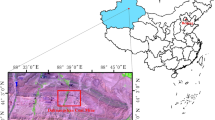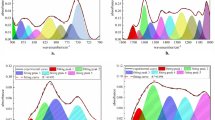Abstract
THE organic matter in coal consists largely of a macromolecular material of complex and variable composition. When coal is pyrolysed, a large fraction is converted to char, and a number of complex aromatic compounds are formed. Because of the extensive chemical change which takes place during this process, however, it is not clear what relationship the products have to the original structure of coal. Many workers have used oxidation procedures to degrade coal to simpler species which are more readily interpreted in terms of coal structure. Oxidation products, however, were in general studied by limited classical organic chemistry methods for separation and identification of products1,2. To date the only aromatic acids definitely identified have been the carboxylic acids of benzene3,4. Commonly used oxidants have been HNO3, HNO3–K2Cr2O7, KMnO4, O2 and H2O2–O3 in conditions for drastic degradation of aromatic rings. On the basis of results of oxidation of coal with a selective oxidant, NaOCl, Chakrabartty and Berkowitz have suggested5 that coal has a largely non-aromatic “tricycloalkane or polyamantane” structure. They pointed out that no evidence for aromatic compounds other than benzene derivatives was found in their oxidation product. Our experimental data do not support this view but rather the generally accepted idea that coal is predominantly an aromatic material.
This is a preview of subscription content, access via your institution
Access options
Subscribe to this journal
Receive 51 print issues and online access
$199.00 per year
only $3.90 per issue
Buy this article
- Purchase on Springer Link
- Instant access to full article PDF
Prices may be subject to local taxes which are calculated during checkout
Similar content being viewed by others
References
van Krevelen, D. W., Coal (Elsevier, Amsterdam, 1961).
Lowry, H. H.(ed.), Chemistry of Coal Utilization, suppl., (Wiley, New York, 1963).
Bitz, M. C., and Nagy, B., Analyt. Chem., 39, 1310 (1967); Proc. natn. Acad. Sci. U.S.A., 56, 1384 (1966).
Yoshino, K., Fuel, 40, 457 (1961).
Chakrabartty, S. K., and Berkowitz, N., Fuel, 53, 240 (1974).
Friedman, L., Fishel, L., and Shechter, H., J. org. Chem., 30, 1453 (1965).
Hayatsu, R., Studier, M. H., Moore, L. P., and Anders, E., Geochim. cosmochim. Acta, 39, 471 (1975).
Beynon, J. H., Saunders, R. A., and Williams, A. E., The Mass Spectra of Organic Molecules (Elsevier, New York, 1968).
Cornu, A., and Massot, R., Compilation of Mass Spectral Data (Heyden, London 1966, 1967 and 1971).
Mass Spectra of Compounds of Biological Interest, 1, and 2 (TID–26553–P1–3, US Atomic Energy Commission, Technical Information Center, Oak Ridge, Tennessee).
Porter, Q. N., and Baldas, J., Mass Spectrometry of Heterocyclic Compounds (Wiley, New York, 1971).
Organic Geochemistry (edit. by Eglington, G.T., and Murphy, M.T.J.), 718 (Pergamon, New York, 1968).
Tingey, G. L., and Morrey, J. R., Coal Structure and Reactivity, Battelle Energy Program Report (Battelle, Pacific Northwest Laboratory, Richland, Washington, 1973).
Schultz, R. F., Schultz, E. D., and Cochran, J., J. Am. chem. Soc., 62, 2902 (1940).
Author information
Authors and Affiliations
Rights and permissions
About this article
Cite this article
HAYATSU, R., SCOTT, R., MOORE, L. et al. Aromatic units in coal. Nature 257, 378–380 (1975). https://doi.org/10.1038/257378a0
Received:
Accepted:
Issue Date:
DOI: https://doi.org/10.1038/257378a0
This article is cited by
-
Lignin-like polymers in coals
Nature (1979)
-
Characterisation of organic acids trapped in coals
Nature (1978)
-
Aromatic structures in coal
Nature (1976)
Comments
By submitting a comment you agree to abide by our Terms and Community Guidelines. If you find something abusive or that does not comply with our terms or guidelines please flag it as inappropriate.



